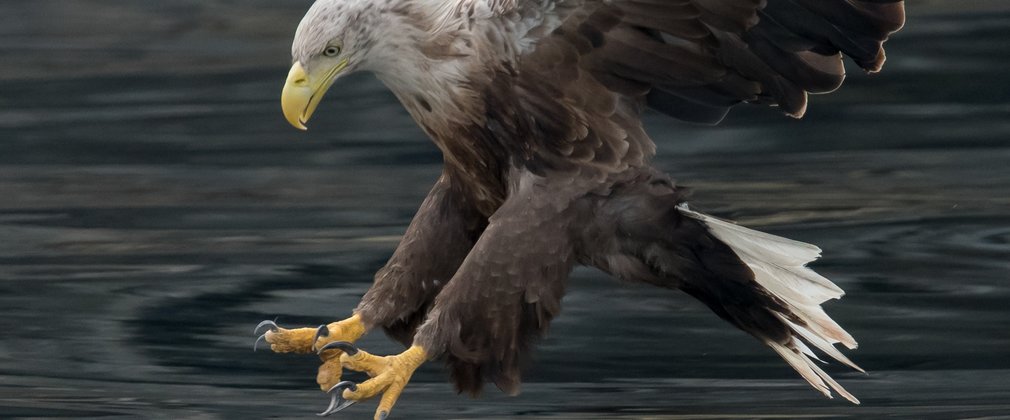
Project will see the birds return to the Isle of Wight after an absence of almost 240 years
Plans to return white-tailed eagles to the South of England have taken a step forward after a licence was issued by the Government’s wildlife licensing authority, Natural England. The licence to reintroduce Britain’s largest bird of prey was granted to The Roy Dennis Wildlife Foundation and Forestry England who will undertake a five year reintroduction programme based on the Isle of Wight.
White-tailed eagles were once widespread across Southern Britain until the eighteenth century when persecution and human activity lead to the birds being wiped out. The last known breeding place in the region was recorded at Culver Cliff on the Isle of Wight in 1780.
The project could give a significant boost to the Island economy after a similar scheme on The Isle of Mull was found to have boosted its local economy by up to £5 million a year.
Roy Dennis, Founder of The Roy Dennis Wildlife Foundation said,
“White-tailed eagles were once a common sight in England and southern Europe but were lost centuries ago. This project aims to reverse that situation by restoring the eagles to their ancestral nesting places. I can remember as a lad walking along Culver Cliffs to see where the eagles had once lived. It is incredible now to be able to play a part in returning these birds back to their home. We look forward to working with a range of organisations on the Island, and in the Solent area, to help make this exciting project a success.”
Bruce Rothnie, South Forest Management Director, at Forestry England, said, “Our woodlands provide a haven for wildlife and we hope that they will become home to these incredible birds on the Isle of Wight. This long term project is a great opportunity to help to restore the white-tailed eagle to the South Coast of England and we are proud to be involved in helping to bring back this rarest of birds to Britain.”
Reintroducing these birds is a priority in the Government’s 25 Year Environment Plan. Implementation of the licence will be closely monitored by Natural England. Public support for the project has been high with 76 per cent of local people surveyed supporting the reintroduction of the birds to the area.
The majestic white-tailed eagle has a wing span over eight foot and a brown plumage with a pale head and distinctive white tail. Over the next five years young birds, bred in the wild in Scotland, will be reintroduced on Forestry England woodland on the Isle of Wight. The young birds will be released once they are familiar with their new home and will initially be fed to encourage them to settle along the South Coast.
It will take several years for the young birds to become established and breeding is not expected to start until at least 2024. During this time the birds will be closely monitored using satellite tracking devices. Data on the movement of the birds will be available on the Roy Dennis Wildlife Foundation website and once the birds are well established it is hoped that viewing areas can be set up to allow visitors to observe the birds.
The Isle of Wight was chosen as a location for the project given its central position on the South Coast, an ideal habitat for these coastal loving birds. In time it is hoped the birds will spread east and west along the coast and also help to link up existing populations of white-tailed eagles living in Ireland and the Netherlands.
The Island offers an ideal habitat for the birds with its numerous potential nesting sites in woods and cliffs, and is located close to highly suitable foraging areas for fish and other food in the Solent and surrounding estuaries.
ENDS
Notes to Editor
- Images of white-tailed eagles are available on request.
- Forestry England manages and cares for the nation’s 1,500 woods and forests. As England’s largest land manager, we shape landscapes and are enhancing forests for people to enjoy, wildlife to flourish and businesses to grow. We have around 1,000 staff, 20,000 volunteers and 80,000 members. For more information visit forestryengland.uk. Forestry England is an agency of the Forestry Commission.
- The Roy Dennis Wildlife Foundation was established in Scotland in 1995 as the Highland Foundation for Wildlife. It is a non-membership charitable trust dedicated to wildlife conservation and research, with a special emphasis on species recovery projects and the restoration of natural ecosystems. Our aim is to carry out important work in the field through project-based activity and to keep administrative overheads to a minimum. We changed our name in June 2017 to the Roy Dennis Wildlife Foundation to reflect Roy’s inspirational contribution to nature conservation and the international scope of our work. You can read about some of the Foundation’s key achievements to date here
- Natural England is the government’s adviser for the natural environment in England, helping to protect England’s nature and landscapes for people to enjoy and for the services they provide.
Within England, Natural England is responsible for:
- Promoting nature conservation and protecting biodiversity
- Conserving and enhancing the landscape
- Securing the provision and improvement of facilities for the study, understanding and enjoyment of the natural environment
- Promoting access to the countryside and open spaces and encouraging open-air recreation
- Contributing in other ways to social and economic well-being through management of the natural environment
Media Contact:
Susan Smith
Media Officer, South Forest District, Forestry England
Tel: 0300 067 4123 Mob: 07384 878434
